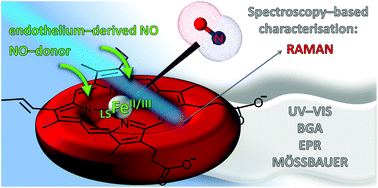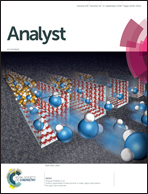Spectroscopy-based characterization of Hb–NO adducts in human red blood cells exposed to NO-donor and endothelium-derived NO†
Abstract
The work presents the complementary approach to characterize the formation of various Hb species inside isolated human RBCs exposed to NO, with a focus on the formed Hb–NO adducts. This work presents a complementary approach based on Resonance Raman Spectroscopy (RRS) supported by Blood Gas Analysis, Electron Paramagnetic Resonance Spectroscopy, UV–Vis Absorption Spectroscopy and Mössbauer Spectroscopy to characterize the formation of various Hb species, with a focus on the Hb–NO adducts formed inside isolated human RBCs exposed to NO, under the experimental conditions of low and high levels of oxygen Hb saturation. In the present work, we induced Hb–NO adducts using PAPA–NONOate, a NO-donor with known chemistry and kinetics of NO release, and confirmed the formation of Hb–NO adducts in RBCs incubated with Human Aortic Endothelial Cells (HAECs) stimulated to produce NO. Our results provide a new insight into the formation of Hb–NO adducts after the exposure of RBCs with high oxyHb content to exogenous NO with special attention to the formation of LSHbIIINO in addition to LSHbIINO and metHb (HS/LSHbIIIH2O). We also point out that reliable characterization of Hb–NO adducts requires complementary techniques. Among them, RRS, as a label-free and non-destructive tool, appears to be an important discrimination technique in the studies of Hb–NO adducts inside intact RBCs.



 Please wait while we load your content...
Please wait while we load your content...